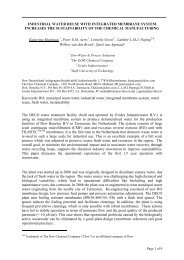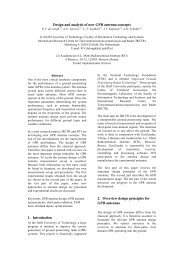CT4860 STRUCTURAL DESIGN OF PAVEMENTS
CT4860 STRUCTURAL DESIGN OF PAVEMENTS
CT4860 STRUCTURAL DESIGN OF PAVEMENTS
You also want an ePaper? Increase the reach of your titles
YUMPU automatically turns print PDFs into web optimized ePapers that Google loves.
2. CONCRETE PAVEMENT STRUCTURE<br />
2.1 General<br />
The top layer of a concrete pavement structure consists of cement concrete<br />
that exhibits an elastic behaviour until the moment of failure (cracking).<br />
Cement concrete has a very high Young’s modulus of elasticity, which results<br />
in a great load spreading in the top layer and hence in low stresses in the<br />
underlying substructure (base plus sub-base plus subgrade).<br />
There are three possibilities to prevent uncontrolled cracking of the top layer<br />
due to shrinkage of the concrete, which occurs during the hardening process<br />
and in hardened concrete due to a decrease of temperature:<br />
- in plain (unreinforced) concrete pavements every 3 to 6 m a transverse<br />
joint is made, and in wide pavements also longitudinal joints are made; this<br />
means that the pavement is divided into concrete slabs;<br />
- in reinforced concrete pavements such an amount of longitudinal<br />
reinforcement (0.6 to 0.75%) is applied, that every 1.5 to 3 m a very<br />
narrow crack occurs;<br />
- in prestressed concrete pavements by prestressing such compressive<br />
stresses are introduced that the (flexural) tensile stresses due to<br />
shrinkage, temperature and traffic loadings stay within acceptable values.<br />
Prestressed concrete pavements are such a specialized (and costly) type of<br />
concrete pavement structure, that they are only applied at some airportplatforms<br />
(for instance at Amsterdam Airport Schiphol), where ‘zero<br />
maintenance’ is very important. In this lecture note no further attention will be<br />
given to prestressed concrete pavements.<br />
The thickness of the (un)reinforced concrete top layer is 150 to 450 mm,<br />
dependent on the traffic loadings, the climate, the concrete quality, the type of<br />
concrete pavement and the properties of the substructure materials.<br />
Considering the great load spreading in the concrete top layer, for reasons of<br />
strength a base is not (always) necessary. Nevertheless generally a base<br />
(with a high resistance to erosion) is applied to prevent as much as possible<br />
the loss of support of the concrete top layer, which could result in unevenness<br />
and/or early cracking of the concrete. Both cement-bound materials and<br />
unbound materials can be applied in the base. Generally the base thickness is<br />
150 to 300 mm.<br />
A sub-base can be necessary to realize an embankment, to prevent damage<br />
due to frost action (in cold climates) or to strengthen the concrete pavement<br />
structure. However, especially on weak subgrades an important reason for<br />
application of a sub-base is that in this way a stable platform is created to<br />
construct the overlying base and/or concrete top layer.<br />
2.2 Subgrade<br />
The Young’s modulus of elasticity of the concrete top layer is much higher<br />
than that of the underlying layers, which means that the top layer takes the<br />
4











